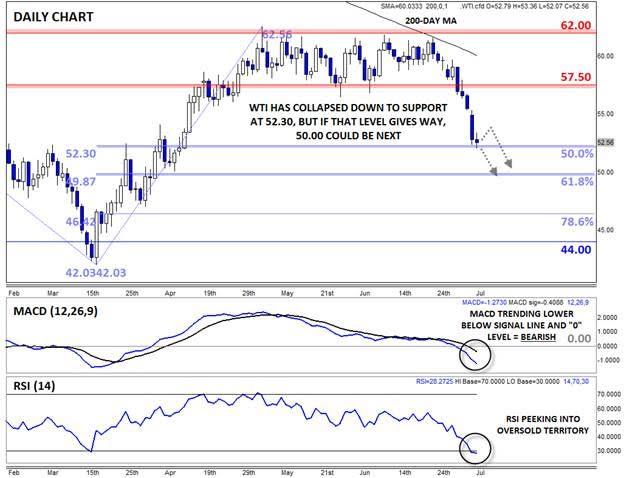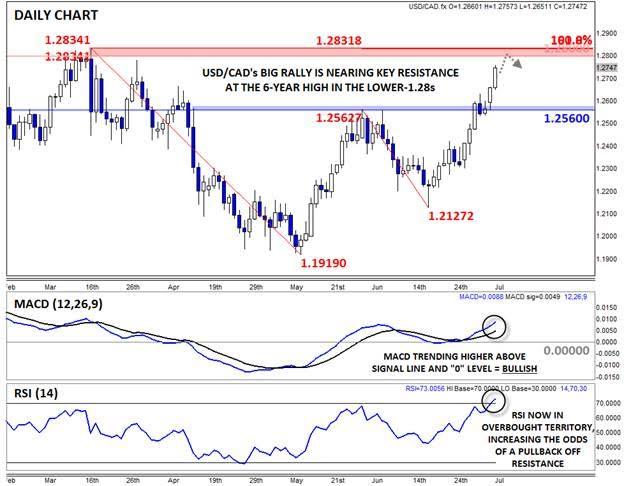![]()
Global traders remain hyper-focused on the latest Greece-related rhetoric from such influential luminaries as Latvia’s Central Bank Governor, Lithuania’s Finance Minister, and even the Finance Minister of Malta, but perhaps investors should be focusing just as much energy on the collapse in the price of …energy.
In particular, oil has gone off the boil, with WTI falling nearly 8% in yesterday’s trade alone. Beyond an last week’s surprising increase in US oil rigs and the ongoing Greek debt drama, the primary catalyst for the drop in oil has been optimism about a nuclear deal with Iran that could eventually bring up to 1 million barrels per day of the country’s oil back to the global market. Over the weekend, Russia’s Foreign Minister said that a deal with Iran “is about 90%” complete and suggested that the remaining issues were more procedural than political.
Combined with last week’s technical breakdown below 57.00, traders took these comments as a green light to drive WTI down to a low near 52.00 so far. “Black gold” is now testing the 50% Fibonacci retracement of its entire Q2 rally at 52.30, but if that level gives way, a continuation down toward the 61.8% retracement near the psychologically-significant $50 level could be next.
Not surprisingly, oil’s implosion has had a big impact on the currencies of oil-dependent economies; The Norwegian krone has fallen to a 3-month low against the greenback (and is within striking distance of its 13-year low), the Russian ruble has turned lower, and the Canadian dollar is quietly making a run toward its 6-year low against the US dollar. In fact, USDCAD has surged nearly 5% over the last three weeks, and bulls are now training their sights on a critical confluence of resistance in the lower-1.28s, where the late January high (1.2799), the mid-March high (1.2834) and the 161.8% Fibonacci extension of the June pullback (1.2832) all converge.
Meanwhile, USDCAD’s daily MACD indicator is trending consistently higher, signaling clear bullish momentum, though the RSI indicator is now in oversold territory, raising the probability of a pullback if and when that level is hit. Until then though, bulls will maintain the upper hand as long as USDCAD holds above previous-resistance-turned-support and this week’s low at 1.2560.
This research is for informational purposes and should not be construed as personal advice. Trading any financial market involves risk. Trading on leverage involves risk of losses greater than deposits.
Recommended Content
Editors’ Picks
AUD/USD jumps above 0.6500 after hot Australian CPI data

AUD/USD extended gains and recaptured 0.6500 in Asian trading, following the release of hotter-than-expected Australian inflation data. The Australian CPI rose 1% in QoQ in Q1 against 0.8% forecast, providing extra legs to the Australian Dollar upside.
USD/JPY hangs near 34-year high at 154.88 as intervention risks loom

USD/JPY is sitting at a multi-decade high of 154.88 reached on Tuesday. Traders refrain from placing fresh bets on the pair as Japan's FX intervention risks loom. Broad US Dollar weakness also caps the upside in the major. US Durable Goods data are next on tap.
Gold price cautious despite weaker US Dollar and falling US yields

Gold retreats modestly after failing to sustain gains despite fall in US Treasury yields, weaker US Dollar. XAU/USD struggles to capitalize following release of weaker-than-expected S&P Global PMIs, fueling speculation about potential Fed rate cuts.
Crypto community reacts as BRICS considers launching stablecoin for international trade settlement

BRICS is intensifying efforts to reduce its reliance on the US dollar after plans for its stablecoin effort surfaced online on Tuesday. Most people expect the stablecoin to be backed by gold, considering BRICS nations have been accumulating large holdings of the commodity.
US versus the Eurozone: Inflation divergence causes monetary desynchronization

Historically there is a very close correlation between changes in US Treasury yields and German Bund yields. This is relevant at the current juncture, considering that the recent hawkish twist in the tone of the Fed might continue to push US long-term interest rates higher and put upward pressure on bond yields in the Eurozone.

